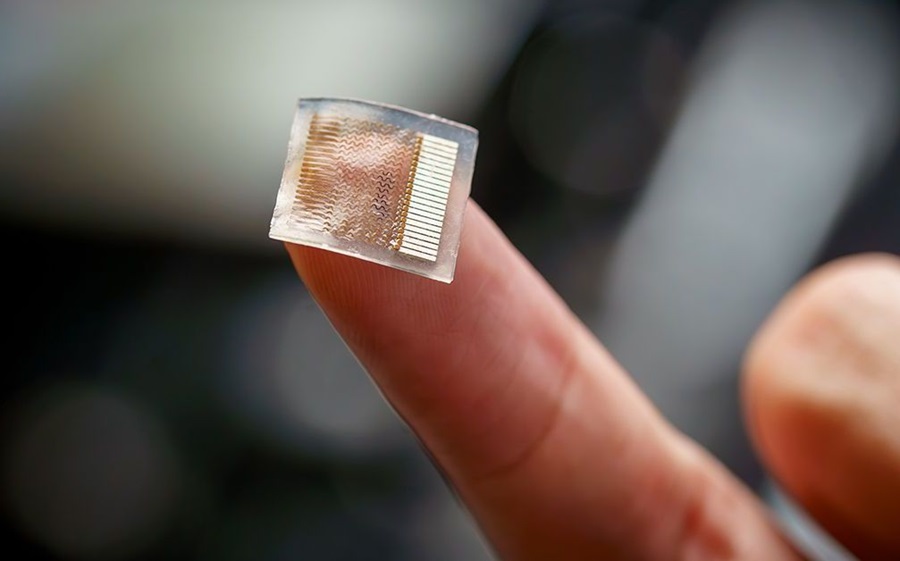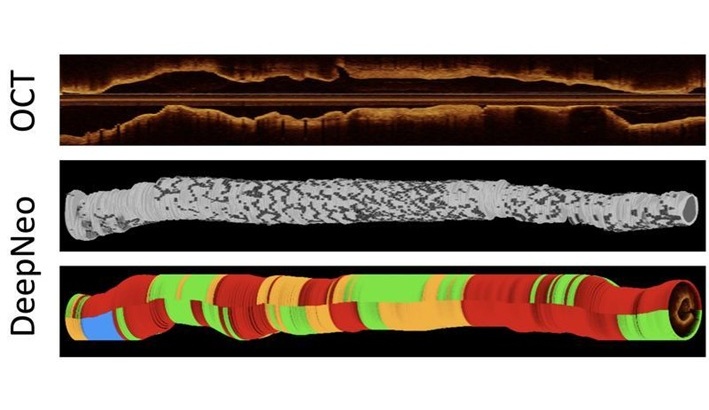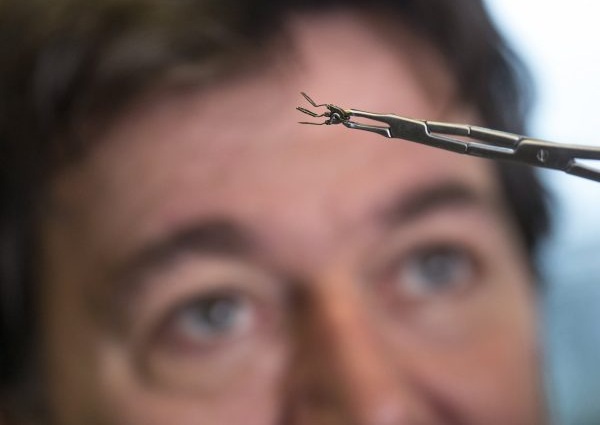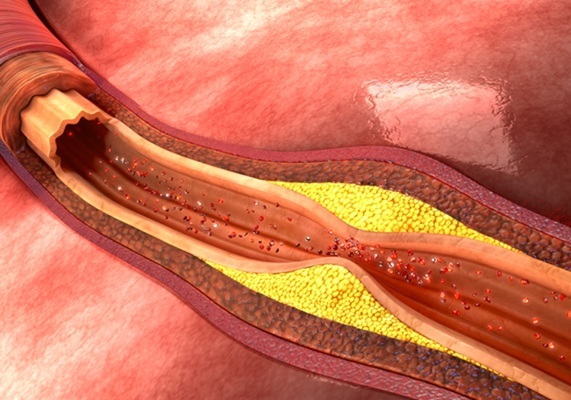Wearable Ultrasound Patch Enables Continuous Blood Pressure Monitoring
|
By HospiMedica International staff writers Posted on 21 Nov 2024 |

Traditional blood pressure measurements using a cuff provide a single, snapshot reading, which can miss important patterns in blood pressure fluctuations. Researchers have now developed an advanced wearable ultrasound patch that allows for continuous, noninvasive blood pressure monitoring. This wearable device offers a constant flow of blood pressure waveform data, enabling detailed tracking of blood pressure trends. The device, which has undergone extensive clinical validation on more than 100 patients, marks a major achievement in continuous cardiovascular health monitoring. Published in Nature Biomedical Engineering, this technology has the potential to transform blood pressure monitoring both in clinical settings and at home.
Developed by researchers at the University of California San Diego (La Jolla, CA, USA), the patch, about the size of a postage stamp, is small, flexible, and adheres to the skin. When placed on the forearm, it provides real-time, precise readings of blood pressure from deep within the body. The patch is composed of silicone elastomer and includes a series of small piezoelectric transducers sandwiched between stretchable copper electrodes. These transducers emit and receive ultrasound waves that track changes in the diameter of blood vessels, translating these signals into blood pressure readings. The new wearable patch builds on an earlier prototype, improving upon it with two key innovations aimed at enhancing its performance for continuous monitoring.
First, the piezoelectric transducers were packed closer together, expanding the patch’s coverage to better target smaller, clinically relevant arteries, such as the brachial and radial arteries. Second, a backing layer was added to dampen excess vibrations from the transducers, improving the clarity of the signals and the accuracy of the tracking. In validation tests, the patch’s results were comparable to those from a traditional blood pressure cuff and the arterial line, a clinical device used for continuous blood pressure monitoring, though the arterial line is highly invasive, limits patient mobility, and can cause discomfort. The patch, however, offers a more simple, reliable, and comfortable alternative.
The researchers performed extensive safety and accuracy tests, involving 117 participants. One set of tests had seven individuals wearing the patch during daily activities like cycling, raising arms and legs, performing mental tasks, meditating, eating, and drinking energy drinks. In a larger group of 85 participants, the patch was evaluated during postural changes, such as moving from sitting to standing. In all tests, the patch’s readings closely matched those of a blood pressure cuff. The device was also tested in a clinical setting with 21 patients in a cardiac catheterization lab and four patients in the intensive care unit after surgery, where the patch’s measurements closely aligned with those from the arterial line. This shows the patch's potential as a noninvasive alternative for blood pressure monitoring. Looking forward, the team is preparing for large-scale clinical trials and plans to incorporate machine learning to enhance the device’s capabilities. They are also working on a wireless, battery-powered version for long-term use, which will integrate seamlessly with hospital systems.
“A big advance of this work is how thoroughly we validated this technology, thanks to the work of our medical collaborators,” said Sheng Xu, a professor in the Aiiso Yufeng Li Family Department of Chemical and Nano Engineering at UC San Diego, in whose lab the device was pioneered. “Blood pressure can be all over the place depending on factors like white coat syndrome, masked hypertension, daily activities or use of medication, which makes it tricky to get an accurate diagnosis or manage treatment. That’s why it was so important for us to test this device in a wide variety of real-world and clinical settings. Many studies on wearable devices skip these steps during development, but we made sure to cover it all.”
Latest Critical Care News
- AI Model Analyzes Patient Data to Diagnose Multiple Sclerosis With 90% Accuracy
- Magnetically Navigable Microparticles Enable Targeted Drug Delivery
- AI-Powered Algorithm Automates Analysis of Coronary Stents After Implantation
- New Stroke Risk Scoring System to Help Avoid Unnecessary Surgeries
- Wearable Device Tracks Individual Cells in Bloodstream in Real Time
- Drug Delivery System Uses Ultrasound-Activated Nanoparticles to Destroy Bacterial Biofilms
- New Potent Injectable Therapy Could Prevent Heart Failure After Heart Attack
- Hospital-Based System Combines AI and Genomic Surveillance to Quickly Detect Infectious Disease Outbreaks
- New Approach to Visualizing Blood Pressure Data Can Help Better Manage Hypertension Patients
- Breakthrough AI Technology Accurately Assesses Heart Failure Severity
- Smart Bandage Monitors Chronic Wounds in Human Patients
- AI Identifies Patients with Increased Lung Cancer Risk Up To 4 Months Earlier
- Next Gen Hemodynamic Monitoring Solution Provides AI-Driven Clinical Decision Support
- AI Algorithm Identifies High-Risk Heart Patients
- Wearable Glucose Monitor Offers Less Invasive Approach to Assessing Diabetes Risk
- Wireless, Self-Powered Smart Insole to Improve Personal Health Monitoring
Channels
Critical Care
view channel
AI Model Analyzes Patient Data to Diagnose Multiple Sclerosis With 90% Accuracy
Multiple sclerosis (MS) is a chronic inflammatory condition affecting the central nervous system. Most patients initially experience the relapsing-remitting form (RRMS), characterized by periods of symptom... Read more
Magnetically Navigable Microparticles Enable Targeted Drug Delivery
Abdominal aortic aneurysms (AAA) can be life-threatening if not treated and result in nearly 10,000 deaths annually. Researchers working to improve treatments for AAA could now make it possible for doctors... Read more
AI-Powered Algorithm Automates Analysis of Coronary Stents After Implantation
Every year, over three million people globally receive stents to open blocked blood vessels caused by heart disease. However, monitoring the healing process after stent implantation remains a significant challenge.... Read moreSurgical Techniques
view channel
DNA Origami Improves Imaging of Dense Pancreatic Tissue for Cancer Detection and Treatment
One of the challenges of fighting pancreatic cancer is finding ways to penetrate the organ’s dense tissue to define the margins between malignant and normal tissue. Now, a new study uses DNA origami structures... Read more
Pioneering Sutureless Coronary Bypass Technology to Eliminate Open-Chest Procedures
In patients with coronary artery disease, certain blood vessels may be narrowed or blocked, requiring a stent or a bypass (also known as diversion) to restore blood flow to the heart. Bypass surgeries... Read more
Intravascular Imaging for Guiding Stent Implantation Ensures Safer Stenting Procedures
Patients diagnosed with coronary artery disease, which is caused by plaque accumulation within the arteries leading to chest pain, shortness of breath, and potential heart attacks, frequently undergo percutaneous... Read more
World's First AI Surgical Guidance Platform Allows Surgeons to Measure Success in Real-Time
Surgeons have always faced challenges in measuring their progress toward surgical goals during procedures. Traditionally, obtaining measurements required stepping out of the sterile environment to perform... Read morePatient Care
view channel
Portable Biosensor Platform to Reduce Hospital-Acquired Infections
Approximately 4 million patients in the European Union acquire healthcare-associated infections (HAIs) or nosocomial infections each year, with around 37,000 deaths directly resulting from these infections,... Read moreFirst-Of-Its-Kind Portable Germicidal Light Technology Disinfects High-Touch Clinical Surfaces in Seconds
Reducing healthcare-acquired infections (HAIs) remains a pressing issue within global healthcare systems. In the United States alone, 1.7 million patients contract HAIs annually, leading to approximately... Read more
Surgical Capacity Optimization Solution Helps Hospitals Boost OR Utilization
An innovative solution has the capability to transform surgical capacity utilization by targeting the root cause of surgical block time inefficiencies. Fujitsu Limited’s (Tokyo, Japan) Surgical Capacity... Read more
Game-Changing Innovation in Surgical Instrument Sterilization Significantly Improves OR Throughput
A groundbreaking innovation enables hospitals to significantly improve instrument processing time and throughput in operating rooms (ORs) and sterile processing departments. Turbett Surgical, Inc.... Read moreHealth IT
view channel
Printable Molecule-Selective Nanoparticles Enable Mass Production of Wearable Biosensors
The future of medicine is likely to focus on the personalization of healthcare—understanding exactly what an individual requires and delivering the appropriate combination of nutrients, metabolites, and... Read more
Smartwatches Could Detect Congestive Heart Failure
Diagnosing congestive heart failure (CHF) typically requires expensive and time-consuming imaging techniques like echocardiography, also known as cardiac ultrasound. Previously, detecting CHF by analyzing... Read moreBusiness
view channel
Expanded Collaboration to Transform OR Technology Through AI and Automation
The expansion of an existing collaboration between three leading companies aims to develop artificial intelligence (AI)-driven solutions for smart operating rooms with sophisticated monitoring and automation.... Read more
















